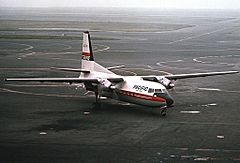Pacific Air Lines Flight 773 facts for kids

The aircraft involved in 1962
|
|
| Hijacking summary | |
|---|---|
| Date | May 7, 1964 |
| Summary | Mass murder |
| Place | Contra Costa County, near Danville, California, U.S. 37°45′33″N 121°52′25″W / 37.75919°N 121.87364°W |
| Passengers | 41 (including the perpetrator) |
| Crew | 3 |
| Fatalities | 44 |
| Survivors | 0 |
| Aircraft type | Fairchild F27A Friendship |
| Airline/user | Pacific Air Lines |
| Registration | N2770R |
| Flew from | Reno–Tahoe International Airport Reno, Nevada |
| Stopover | Stockton Metropolitan Airport Stockton, California |
| Flying to | San Francisco International Airport San Francisco, California |
Pacific Air Lines Flight 773 was a Fairchild F27A Friendship airplane. It crashed on May 7, 1964, near Danville, California. This area is a suburb located east of Oakland.
This sad event was likely the first time in the United States that an airplane's pilots were attacked by a passenger. This attack led to a terrible crash, killing everyone on board. A passenger named Francisco Paula Gonzales, who was 27 years old, attacked the pilots. This caused the plane to crash, and all 44 people on board died.
The Aircraft
The plane involved in this accident was a Fairchild F-27. It had two engines and was a type of plane called a turboprop. Its registration number was N2770R. This aircraft was a version of the Fokker F-27 Friendship airliner, but it was built in the U.S.
The plane was made in 1959. By the time of its last flight, it had flown for about 10,250 hours. Pacific Air Lines was the only company that owned and operated this specific plane.
The Flight Journey
Flight 773 took off from Reno, Nevada, at 5:54 AM Pacific Daylight Time. There were 33 passengers on board, including Francisco Gonzales. The plane also had a crew of three people. Its final destination was San Francisco International Airport. The flight was scheduled to make a stop in Stockton, California first.
The crew members were Captain Ernest Clark, who was 52 years old and the pilot in charge. The copilot was First Officer Ray Andress, 31. The flight attendant was Margaret Schafer, 30.
The plane landed in Stockton as planned. Two passengers got off the plane there, and 10 new passengers boarded. This brought the total number of passengers to 41. The two passengers who got off in Stockton later told investigators that Gonzales was sitting right behind the cockpit. Around 6:38 AM, Flight 773 took off again from Stockton. It was heading towards San Francisco International Airport.
The Investigation Begins
Investigators from the Civil Aeronautics Board (CAB) looked into the crash. The CAB was an organization that later became part of today's National Transportation Safety Board (NTSB). In the damaged wreckage, they found a broken Smith & Wesson Model 27 .357 Magnum revolver. This gun had six empty bullet casings.
The Federal Bureau of Investigation (FBI) soon joined the CAB. They worked together to find clues because the crash seemed to be a crime. Investigators discovered that when Gonzales flew from San Francisco to Reno the day before the crash, he was carrying the .357 gun. They also found out that he had bought a very large amount of life insurance at the San Francisco airport. This money, about $105,000, would go to his wife if he died. This was a very important clue for the investigators.
Changes for Safety
After this tragic event, new rules for air travel were put in place. These new rules became official on August 6, 1964. They stated that the doors between the passenger area and the cockpit on all regular airplanes must be kept locked during the flight.
There is one exception to this rule. On some planes, like the Fairchild F-27, the cockpit door also leads to an emergency exit for passengers. In these cases, the door might not be locked during takeoff and landing. These new safety rules were actually planned by the Federal Aviation Administration before the Flight 773 crash. However, they had not yet become effective when the accident happened.

